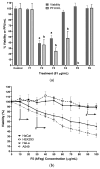In Vitro Evaluation of the Anti-Chikungunya Virus Activity of an Active Fraction Obtained from Euphorbia grandicornis Latex
- PMID: 39772236
- PMCID: PMC11680167
- DOI: 10.3390/v16121929
In Vitro Evaluation of the Anti-Chikungunya Virus Activity of an Active Fraction Obtained from Euphorbia grandicornis Latex
Abstract
Chikungunya virus (CHIKV) is classified as a pathogen with the potential to cause a pandemic. This situation becomes more alarming since no approved drug exists to combat the virus. The present research aims to demonstrate the anti-CHIKV activity of molecules present in the latex of Euphorbia grandicornis. Therefore, a biodirected assay was carried out to find the molecules with anti-CHIKV activity. Extractions with hexane, dichloromethane, and methanol and subsequent purification by column chromatography were carried out to later evaluate cytotoxic activity by 3-(4,5-dimethyl-2-thiazolyl)-2,5-diphenyl-2H-tetrazolium bromide (MTT) assay and antiviral activity by plaque assay. Our findings show that unlike the others, methanolic extract has a low cytotoxic effect and a good anti-CHIKV effect (EC50 = 26.41 µg/mL), which increases when obtaining the purified active fraction (pAFeg1) (EC50 = 0.4835 µg/mL). Time-of-addition suggests that the possible mechanism of action of pAFeg1 could be inhibiting any of the non-structural proteins of CHIKV. In addition, both the cytotoxic and anti-CHIKV activity of pAFeg1 demonstrate selectivity since it killed cancer cells and could not inhibit DENV2.
Keywords: Euphorbia grandicornis; antiviral; cancer cells; chikungunya virus; cytotoxic; latex; oleanolic acid; roburic acid; selectivity.
Conflict of interest statement
The authors declare no conflicts of interest.
Figures










References
-
- Weinbren M.P. The occurrence of Chikungunya virus in Uganda. II. In man on the Entebbe peninsula. Trans. R. Soc. Trop. Med. Hyg. 1958;52:258–259. - PubMed
Publication types
MeSH terms
Substances
Grants and funding
LinkOut - more resources
Full Text Sources
Medical

